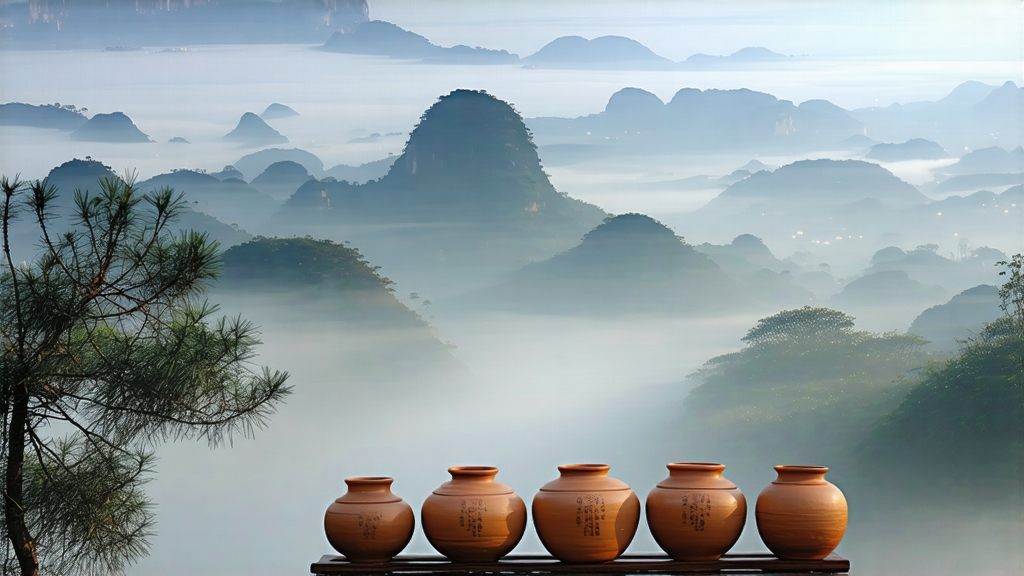
Tucked away in the humid, karst-pocked southwest of China, the small town of Liubao in Guangxi Zhuang Autonomous Region guards a tea secret that once traveled the ancient Tea-Horse Road, perfumed the holds of clipper ships bound for Southeast Asia, and still hides in the cupping bowls of only the most curious tea professionals. Liubao heicha—literally “dark tea from Six Forts”—is the least flamboyant yet most aromatically complex member of China’s dark-tea family. While Pu-erh hoards the spotlight, Liubao whispers of damp cellars, betel nut, and orchards after rain, offering a mellow, digestive warmth that Cantonese yum-cha culture has prized for three centuries.
History: From Frontier Garrison to Maritime Gold
The name first appears in 1640 county annals, when Ming troops stationed at the six strategic forts along the Cangwu Ridge were paid partly in compressed tea. The leaf was pressed into long bamboo tubes and traded for horses with mountain tribes, a practice that grafted military logistics onto tea culture. By the late Qing, Liubao had become a currency in its own right: bricks and baskets moved down the Xun River to Wuzhou, then through the Pearl River Delta to Hong Kong, Singapore, and Kuala Lumpur, where tin-mine coolies swore it cured dysentery and “cut the grease” of opium smoke. European botanical texts of 1886 list “Lew-Pow” alongside Lapsang Souchong as one of the two black teas worth analyzing—proof that Liubao sailed out of China before the concept of “dark tea” was even codified.
Terroir: Where Humidity Writes Flavor
The microclimate is a marriage of subtropical monsoon and limestone drainage. Mist rises between finger-like karst peaks, keeping year-round humidity above 80 %. The soil is a reddish sandy loam rich in potassium and magnesium—minerals that later translate into a sweet, saline finish in the cup. Tea gardens sit between 200–600 m, lower than Yunnan’s pu-erh mountains, so the leaves grow broader and thinner, ideal for the aggressive fermentation that follows.
Leaf Material: One Bush, Two Standards
Only the local large-leaf variety, Camellia sinensis var. sinensis f. Liubao, is legally permitted. Farmers pick two standards: “one bud three leaves” for premium grades destined for bamboo-basket aging, and “one bud four or five leaves” for mass-market bricks. The latter carries more stem, which ferments faster and lends a woody note reminiscent of old cigar boxes.
Craft: The Secret 48-Hour “Dui Wei”
Unlike pu-erh’s months-long wo dui, Liubao’s wet-pile fermentation is a sprint. After brief withering, leaves are wok-fired at 280 °C for eight minutes—just enough to kill green enzymes while retaining surface moisture. They are then piled 70 cm deep inside cedar-lined chambers. A mist of indigenous microbes (predominantly Aspergillus niger and Blastobotrys adeninivorans) is sprayed on, and the pile is covered with jute sacks. For the next 48 hours the tea reaches 58 °C; workers turn it every four hours to oxygenate the core. The result is a leaf that is 70 % oxidized yet still biologically active, ready to continue breathing inside its storage vessel.
Compression & Aging Vessels: Bamboo, Clay, and Time
Traditional baskets, called longlan, are woven from three-year-old mao bamboo, smoked over camphor wood to remove sugars that attract insects. A cotton paper liner is brushed with rice-water paste, the warm tea is tamped in by foot, and the basket is lidded and strapped with rattan. These 30–50 kg globes are stacked in riverside caves where humidity hovers at 88 % and temperature at 26 °C. Over decades the tea absorbs cave air, bamboo lactones, and trace minerals leaching from karst walls, developing the hallmark “betel-nut” aroma—an earthy, camphor-sweet note that perfumers compare to aged agarwood.
Grades & Shapes
- San Cha (loose leaf): air-dried after dui wei, then stone-pressed into 100 g “tuo” domes; fastest aging, most volatile aroma.
- Gong Cha: select baskets aged 3–5 years; golden tips